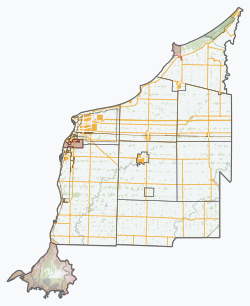Sarnia | |
|---|---|
City (lower-tier) | |
| City of Sarnia | |
 | |
| Nickname: The Imperial City | |
| Motto(s): Sarnia Semper (Latin for "Sarnia Always") | |
| Coordinates: 42°58′53″N 82°19′04″W / 42.98139°N 82.31778°W[1] | |
| Country | Canada |
| Province | Ontario |
| County | Lambton |
| Settled | 1830s |
| Incorporated | 19 June 1856 (town) |
| Incorporated | 7 May 1914 (city) |
| Government | |
| • Mayor | Mike Bradley |
| • Governing Body | Sarnia City Council |
| • MPs | Marilyn Gladu (CPC) |
| • MPPs | Bob Bailey (OPC) |
| Area | |
• City | 163.90 km2 (63.28 sq mi) |
| • Metro | 1,118.65 km2 (431.91 sq mi) |
| Elevation | 180.60 m (592.52 ft) |
| Population (2021)[2] | |
• City | 72,047 (83rd) |
| • Density | 439.6/km2 (1,139/sq mi) |
| • Metro | 97,592 (44th) |
| Forward sortation area | |
| Area codes | 519, 226 and 548 |
| Website | www |
Sarnia is a city in Lambton County, Ontario, Canada. It had a 2021 population of 72,047,[2] and is the largest city on Lake Huron. Sarnia is located on the eastern bank of the junction between the Upper and Lower Great Lakes, where Lake Huron flows into the St. Clair River in the Southwestern Ontario region, which forms the Canada–United States border, directly across from Port Huron, Michigan.
The site's natural harbour first attracted the French explorer La Salle. He named the site "The Rapids" on 23 August 1679, when he had horses and men pull his 45-ton barque Le Griffon north against the nearly four-knot current[5] of the St. Clair River.[6] This was the first time that a vessel other than a canoe or other oar-powered vessel had sailed into Lake Huron,[7] and La Salle's voyage was germinal in the development of commercial shipping on the Great Lakes.[8] Located in the natural harbour, the Sarnia port remains an important centre for lake freighters and oceangoing ships carrying cargoes of grain and petroleum products.[9] The natural port and the salt caverns that exist in the surrounding areas,[10] together with the oil discovered in nearby Oil Springs in 1858,[11] led to the dramatic growth of the petroleum industry in this area. Because Oil Springs was the first place in Canada and North America to drill commercially for oil, the knowledge that was acquired there resulted in oil drillers from Sarnia travelling the world teaching other enterprises and nations how to drill for oil.[12]
The complex of refining and chemical companies is called "Chemical Valley" and located south of downtown Sarnia.[13] In 2011 the city had the highest level of particulates air pollution of any Canadian city, but it has since dropped to rank 30th in this hazard.[14] About 60 percent of the particulate matter comes from industries and polluters in the neighbouring United States.[15]
Lake Huron is cooler than the air in summer and warmer than the air in winter; therefore, it moderates Sarnia's humid continental climate, making temperature extremes of hot and cold less evident.[4] In the winter, Sarnia occasionally experiences lake-effect snow from Arctic air blowing across the warmer waters of Lake Huron and condensing to form snow squalls over land.[16]
- ^ "Sarnia". Geographical Names Data Base. Natural Resources Canada.
- ^ a b c "Profile table, Census Profile, 2021 Census of Population - Sarnia, City (CY) [Census subdivision], Ontario". Canada 2021 Census. Statistics Canada. 9 February 2022. Retrieved 25 August 2022.
- ^ "Census Profile, 2021 Census – Sarnia (Census agglomeration), Ontario and Lambton, County (Census division), Ontario". Canada 2021 Census. Statistics Canada. 8 February 2017. Retrieved 29 August 2023.
- ^ a b "National Climate Data and Information Archive, 1971–2000". Government of Canada. Retrieved 12 April 2012.
- ^ "Great Lakes Currents". NOAA/NOS/CO-OPS. Archived from the original on 24 July 2008. Retrieved 30 March 2012.
- ^ "La Salle and the Griffon". Retrieved 23 August 2013.
- ^ "The Griffon". Ontario Visual Heritage project. 2012. Retrieved 30 March 2012.
- ^ Mansfield, J.B., ed. (1899). History of the Great Lakes: Volume I. Chicago, Illinois: J.H. Beers & Co. pp. 78–90.
- ^ Morden, Paul (7 November 2012). "Great Lakes Shipping Future Looks Bright". The Sarnia Observer. Archived from the original on 5 March 2016. Retrieved 27 June 2013.
- ^ "Ministry of Natural Resources-Salt Caverns". Ministry of Natural Resources. 5 June 2009. Archived from the original on 7 October 2008. Retrieved 12 April 2012.
- ^ Clinton Tippett (2014). "Timeline-Global Petroleum History" (PDF). Petroleum History Society. Retrieved 12 May 2018.
- ^ Gary May (1998). Hard Oiler-The Story of Canadians' Quest for Oil at Home and Abroad. Dundurn Press, Ltd. pp. 8, 10, 121.
- ^ "The Chemical Valley--Part I". Vice News. Archived from the original on 9 January 2015. Retrieved 19 January 2016.
- ^ "WHO ranks Canada's urban air among best in world". WHO. 2016.
- ^ "Sarnia Air Canada's Worst". Sarnia Observer. Archived from the original on 9 November 2012. Retrieved 19 January 2016.
- ^ Craig Pearson (15 December 2010). "Lake Effect Fuels Snowbelt Storms". The Windsor Star. Archived from the original on 2 October 2013. Retrieved 12 April 2012.




